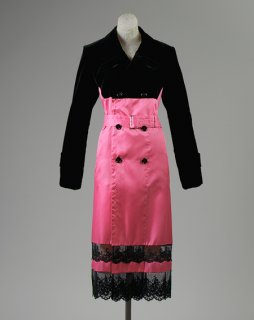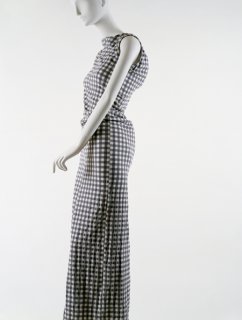You are using an out of date browser. It may not display this or other websites correctly.
You should upgrade or use an alternative browser.
You should upgrade or use an alternative browser.
The Comme des Garçons "Universe"
- Thread starter déjàvu
- Start date
It is a new one. I think it will be released in April.
The notes:
Head: bitter orange, black pepper. lime and saffron.
Heart: thyme, sage and sea notes.
Base: oak moss, patchouli and musk.
Sounds quite promising (patchouli, bitter orange and saffron)
But sea notes (aka Acqua di Gio, Issey Miyake) ?:-P
The notes:
Head: bitter orange, black pepper. lime and saffron.
Heart: thyme, sage and sea notes.
Base: oak moss, patchouli and musk.
Sounds quite promising (patchouli, bitter orange and saffron)
But sea notes (aka Acqua di Gio, Issey Miyake) ?:-P
nqth said:It is a new one. I think it will be released in April.
The notes:
Head: bitter orange, black pepper. lime and saffron.
Heart: thyme, sage and sea notes.
Base: oak moss, patchouli and musk.
Sounds quite promising (patchouli, bitter orange and saffron)
But sea notes (aka Acqua di Gio, Issey Miyake) ?:-P
gee thanks nqth.........
do you live in fashion spot ??.......B)
BTW why do you say ......"theyare Crazy ' >?? : )
i sure as hell hope it will have NOTHING To do with Gio or issey......i absoltely HATE those scents ...
pity the Play parfums bottle is the same as Odeur 53......too chunky IMO
once again thanks for the speedy reply
Last edited by a moderator:
^I wish I could:-))
I haven't seen anybody making perfumes in such a childish and non-serious manner:-) Must give them credits for having fun in serious business.
It must be a bitter fresh scent.
We might see the come back of see notes. Mugler does it, too, in his newest scent.
I haven't seen anybody making perfumes in such a childish and non-serious manner:-) Must give them credits for having fun in serious business.
It must be a bitter fresh scent.
We might see the come back of see notes. Mugler does it, too, in his newest scent.
good nqth
i think CDG is pretty clever to do all these perfumes in all the "crazy" manner as they always try to be different and are famous for it .....
BUT then again look at their bottles ..its a rehash of the Odeur 53 series and all they needed was to create the scent and lets face it its probably not that expensive to do that ....
the scents they have been coming out with hasnt been that exciting ...eg SWEET which was cheap and tacky ..lets be honest ......!!!!
but hopefully they can be a bit more serious thye for Play parfum
nqth .... would you know if goods at GSTORES are cheaper than at the normal shops ? ..and how does it affect the custom at the normal shops that also sell comme in the same city eg berlin ??
do give a review of the play perfume when you get it in cracow and also please post some good pix !!!
thanks n!!
i think CDG is pretty clever to do all these perfumes in all the "crazy" manner as they always try to be different and are famous for it .....
BUT then again look at their bottles ..its a rehash of the Odeur 53 series and all they needed was to create the scent and lets face it its probably not that expensive to do that ....
the scents they have been coming out with hasnt been that exciting ...eg SWEET which was cheap and tacky ..lets be honest ......!!!!
but hopefully they can be a bit more serious thye for Play parfum
nqth .... would you know if goods at GSTORES are cheaper than at the normal shops ? ..and how does it affect the custom at the normal shops that also sell comme in the same city eg berlin ??
do give a review of the play perfume when you get it in cracow and also please post some good pix !!!
thanks n!!
Yes I think it's their way (crazy) but some perfumes are good anyway.
I love the BurntSugar and Wood Coffee. NomadTea is not bad. I think it's very uncommon to make sweet but raw perfume, without the "preciousness or refinement, but in quite a primitive and home made way. It is indeed very Comme way. I wear BS nonstop and have never got tired of it:-) In fact bc it is so strong and sweet it become addicting. And I just can't wear other sweet perfumes (Serge Lutens or Malle).
I don't think the PLAY is a serious, complex scent tho. I guess it's rather a fun summer scent.
The price of current collections at the Warsaw G is the same as normal stores I think. Might be even higher since the VAT is high here (22%) I have no idea about Berlin tho. They used to have Comme at quartier 206 but I don't know if the store still stocks Comme now.
I love the BurntSugar and Wood Coffee. NomadTea is not bad. I think it's very uncommon to make sweet but raw perfume, without the "preciousness or refinement, but in quite a primitive and home made way. It is indeed very Comme way. I wear BS nonstop and have never got tired of it:-) In fact bc it is so strong and sweet it become addicting. And I just can't wear other sweet perfumes (Serge Lutens or Malle).
I don't think the PLAY is a serious, complex scent tho. I guess it's rather a fun summer scent.
The price of current collections at the Warsaw G is the same as normal stores I think. Might be even higher since the VAT is high here (22%) I have no idea about Berlin tho. They used to have Comme at quartier 206 but I don't know if the store still stocks Comme now.
Last edited by a moderator:
The Osaka store's facade (very much like the HKK:-)

pictures by akaitori:
http://www.flickr.com/photos/akaitori/

pictures by akaitori:
http://www.flickr.com/photos/akaitori/
La bordélique
earthbound
- Joined
- Mar 2, 2006
- Messages
- 4,703
- Reaction score
- 8
Source: metmuseum.org
[/FONT][/FONT]

[FONT=geneva,arial,sans-serif]Ensemble, autumn/winter 2001–2
Rei Kawakubo (Japanese, born 1942), for Comme des Garçons (French, founded 1969)
Black cotton velvet; red cotton velvet; pink rayon satin with black cotton tulle and synthetic lace
Gift of Comme des Garçons, 2004 (2004.188ab)
[FONT=geneva,arial,sans-serif]Part of the "Beyond Taboo" collection, this ensemble by Rei Kawakubo references a brassiere from the 1950s, the period of the bust's most highly eroticized focus. However, Kawakubo cites its least provocative form, the long-line, and she fashions her design in a cotton voided velvet fabric that situates it as outerwear. The long-line was originally intended to provide greater support for women with larger breasts, the ostensible period ideal. But the detailing was more orthopedic than sexy, and Kawakubo stresses this practicality in her version. When she transposes the brassiere to the rear, however, her critique of the sexist equivalence of the cleavage of breasts to that of the buttocks flirts dangerously with a reinvestment of the erotic to the garment.
[/FONT][/FONT]

Dress, spring/summer 1997
Rei Kawakubo (Japanese, born 1942), for Comme des Garçons (French, founded 1969)
Gray and white gingham checked nylon and elasticine blend
Gift of Barneys New York, 1998 (1998.516.1a,b)
[FONT=geneva,arial,sans-serif]Spurring controversy in the fashion press and consumer public, and inspiration among design peers, the bulbous gingham dresses of Rei Kawakubo's 1997 women's line literally challenged the form of fashion. While Kawakubo has clearly demonstrated an interest in challenging various social, sexual, and economic stereotypes with her garments, this dress confronted one of the oldest taboos of fashionable and wealthy society: the shapes of the feminine ideal. Said to have been exploring the boundaries of malleable form in movement with padded bumps at bust, rear, and midriff combined with a stretchy synthetic gingham, Kawakubo has never verbally confirmed a frustration with fashion's passion for fit, even emaciated models and mannequins.
The gingham, commissioned from the Orimono Kenkyu Sha Fabric Company and its designer, Hiroshi Matsushita, fit so tautly over the projectile padding that it denoted a second skin. This rather disturbing imagery prompted many to view the pieces as a twisted tribute to deformity or disfiguration. Kawakubo, who has been labeled melancholic for her early use of black, has declined comment on these criticisms and allegations. Much like Issey Miyake, she believes that a company should have its own theory and persona, separate and different from that of its patriarch or matriarch, and thereby unfailingly allows her work to speak for itself.
[/FONT]

mikka000 said:why do people think that Comme des Garcons is French? Rei lives in Aoyama, Tokyo and that's where the studio is too. It's really frustrating!
Because people are ignorant.
marylauda said:^To someone who doesn't know much about the label, I think that it would be an easy mistake to make, considering "comme des garcons" are French words.
but the information above that is quoted with the pictures is wrong. fair enough if someone thinks CdG is French but to publish 'factual' information that refers to CdG as being French is silly. They just have to do a little research to get the right answer.
La bordélique
earthbound
- Joined
- Mar 2, 2006
- Messages
- 4,703
- Reaction score
- 8
GuerrillaBoy
Member
- Joined
- Jan 11, 2006
- Messages
- 334
- Reaction score
- 0
????
I was in Paris, but i didnt see any new line???!?! could you please explain...
thanks
"CdG presented a new label called ganryu in paris for the first time in two years"
WWD
seems like the start is on a small scale, but it's one designer line.
I was in Paris, but i didnt see any new line???!?! could you please explain...
thanks

i found this picture of ganryu (?) with one of his designs on a danish blog.
"Hvis Comme des Garcons vælger at lade dig præsentere din første kollektion i deres showroom, så er du allerede halvvejs mod dit mål. Dette scenarium udspillede sig under modeugen i Paris for den japanske designer Ganryu, som udover at designe sit eget mærke også designer for Junya Watanabe. Vi ved desværre stadigvæk ikke om kollektionen overhovedet vil komme på markedet, mens hans ting er alligevel værd at nævne. Kollektionen bestod af printed t-shirts, redesignede jersey hoods, accessories og i fantastiske halsdekorationer var kludedukker blevet vækket til live igen."
source: http://www.cover.dk/
GuerrillaBoy
Member
- Joined
- Jan 11, 2006
- Messages
- 334
- Reaction score
- 0
I found it too, but can someone translate... thank you
Similar Threads
- Replies
- 20
- Views
- 11K
- Replies
- 4
- Views
- 4K
Users who are viewing this thread
Total: 1 (members: 0, guests: 1)
New Posts
-
-
-
-
US Vogue ‘Best Dressed’ 2025 : Bad Bunny by Coco Capitán & Alex Consani by Ethan James Green (9 Viewers)
- Latest: mepps
-










